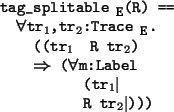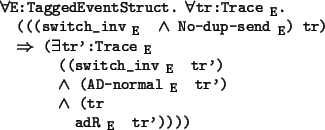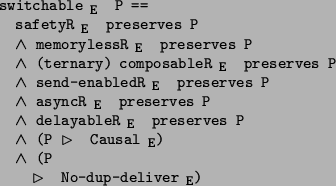
proof: If tr has properties I and K, and if m:Label. (P tr

The outline of the argument we use to remove the normal form requirement is contained in
the following lemma.
![]()

proof: If tr has properties I and K, and if m:Label. (P tr![]() ), then we must show
P tr assuming the six hypotheses. Using the fifth hypothesis, we find tr', related to tr by
R and satisfying I and J. Since R preserves K, trace tr' also satisfies K.
Using the fusion hypothesis, we can conclude that P tr' if we can show m:Label. (P tr'
), then we must show
P tr assuming the six hypotheses. Using the fifth hypothesis, we find tr', related to tr by
R and satisfying I and J. Since R preserves K, trace tr' also satisfies K.
Using the fusion hypothesis, we can conclude that P tr' if we can show m:Label. (P tr'![]() ).
This follows from the assumptions that R is tag-splitable and preserves P. Once we have
P tr', we conclude P tr from the assumptions that R is a symmetric relation and
preserves P.
).
This follows from the assumptions that R is tag-splitable and preserves P. Once we have
P tr', we conclude P tr from the assumptions that R is a symmetric relation and
preserves P.
The K we need in the previous argument is No-dup-send
![]() , and the R is adR
, and the R is adR
![]() . That
R preserves K follows from the next two lemmas whose proofs are straightforward.
. That
R preserves K follows from the next two lemmas whose proofs are straightforward.
![]()
![]()
![]()
![]()
When we instantiate lemma 5.4.2 with K and R as above and with
switch_inv
![]() for I and AD-normal
for I and AD-normal
![]() for J, then the last hypothesis is
theorem 5.4,
and, as we have seen, the first four hypotheses are all satisfied. The fifth hypothesis becomes
the following lemma, which we will prove.
for J, then the last hypothesis is
theorem 5.4,
and, as we have seen, the first four hypotheses are all satisfied. The fifth hypothesis becomes
the following lemma, which we will prove.
![]()

Once lemma 5.4.5
is proved, we see that we have the following theorem, which
is essentially our main result.
![]()

Proof of lemma 5.4.5
: We use the following general theorem on the existence
of partially sorted lists. It says that by swapping adjacent elements x,y
of list L, for which (P x y), provided that each swap results in a pair that
satisfies P, we may reach a sorted list L' in which all adjacent pairs satisfy P.
![]()
![\begin{program*}
\> \\
\> \mforall{}T:\mBbbU{}. \mforall{}L:T List. \mforall{}P...
...\vert L'\vert\vert - 1\\
\> (P L'[i] \\
\> L'[i\\
\> + 1])))))
\end{program*}](img109.png)
proof: The proof is by induction on the cardinality of the set of bad pairs-
the pairs for which (P x y) and where x precedes y in L (but is not necessarily adjacent).
If P is decidable, we can find an adjacent bad pair, if one exists,
and show that swapping decreases the cardinality of the set of bad pairs.
We apply theorem 5.6 with P instantitated to

We must show that ad-normalR
![]() is decidable, which is easy, and that
is decidable, which is easy, and that
![]()
This follows from the No-dup-send
![]() property of tr, since if (a,b) is a pair of
out of order deliveries then (b,a) will not be out of order since there are unique send
events for them. The partial sort theorem then gives us a trace tr' reachable from trace
tr by swapping adjacent pairs for which (ad-normalR
property of tr, since if (a,b) is a pair of
out of order deliveries then (b,a) will not be out of order since there are unique send
events for them. The partial sort theorem then gives us a trace tr' reachable from trace
tr by swapping adjacent pairs for which (ad-normalR
![]() a b), and for which all adjacent
pair satisfy ad-normalR
a b), and for which all adjacent
pair satisfy ad-normalR
![]() . We must show that tr adR
. We must show that tr adR
![]() tr', that switch_inv
tr', that switch_inv
![]() tr',
and that AD-normal
tr',
and that AD-normal
![]() tr'. The first of these follows from the observation that
swapping adjacent pairs for which (ad-normalR
tr'. The first of these follows from the observation that
swapping adjacent pairs for which (ad-normalR
![]() a b) always swaps pairs allowed by
either the relation asyncR
a b) always swaps pairs allowed by
either the relation asyncR
![]() or the relation delayableR
or the relation delayableR
![]() . The second requirement
follows from the assumption that switch_inv
. The second requirement
follows from the assumption that switch_inv
![]() tr, and the following lemma,
whose proof is straightforward, which shows that swapping pairs for which
(ad-normalR
tr, and the following lemma,
whose proof is straightforward, which shows that swapping pairs for which
(ad-normalR
![]() a b) preserves the property switch_inv
a b) preserves the property switch_inv
![]() .
.
![]()

To finish the proof of lemma 5.4.5
it remains to show that if all adjacent
element of tr' satisfy ad-normalR
![]() then tr' satisfies AD-normal
then tr' satisfies AD-normal
![]() . It can easily be seen that if all adjacent pairs satisfy
ad-normalR
. It can easily be seen that if all adjacent pairs satisfy
ad-normalR
![]() then tr' is in normal form. But the dependence of
ad-normalR
then tr' is in normal form. But the dependence of
ad-normalR
![]() on parameter tr is only on the order of send events in tr, and this
order is preserved by the swaps that lead from tr to tr'.
on parameter tr is only on the order of send events in tr, and this
order is preserved by the swaps that lead from tr to tr'.
We restate theorem 5.5 by combining its hypotheses into the
definition of a switchable property.

![]()
